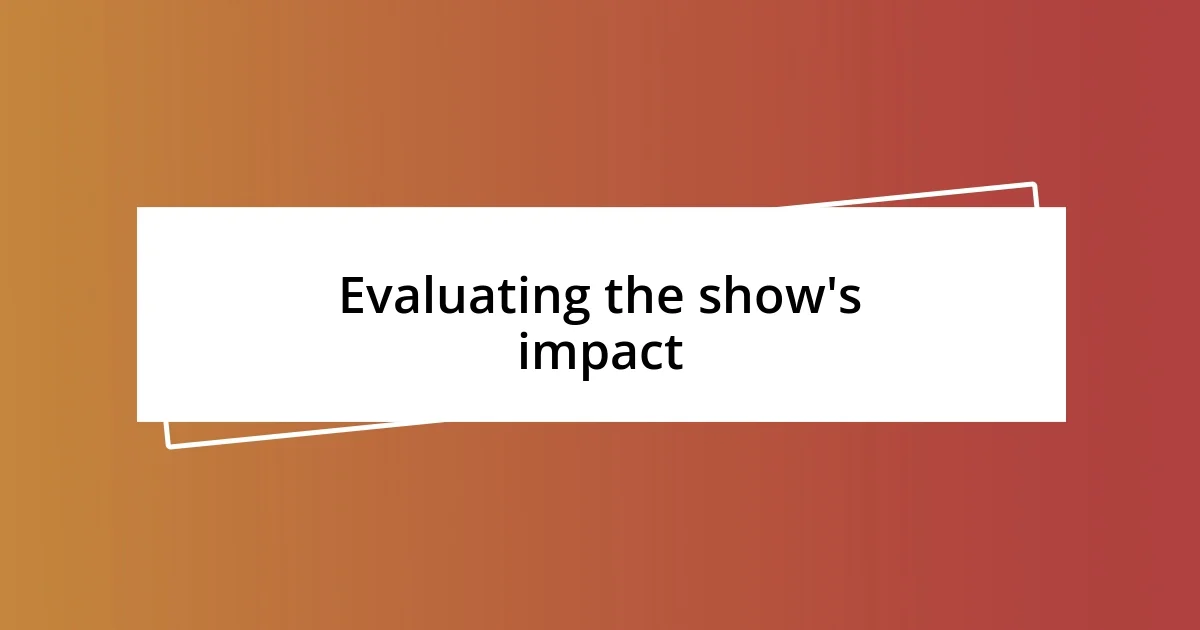Key takeaways:
- Choosing an eco-friendly venue that supports sustainability enhances the event’s message and creates a unique ambiance.
- Selecting designers who prioritize ethical practices and eco-friendly materials cultivates a community centered on sustainable fashion.
- Implementing waste reduction strategies, such as a zero waste policy and community engagement, transforms perceptions of waste into creative opportunities.

Planning the sustainable fashion show
Planning a sustainable fashion show involves more than just the clothes on display; it’s about weaving together a vision that resonates with both the audience and the environment. I remember the excitement and anxiety when I first brainstormed ideas with my team, wondering how we could minimize waste while still delivering a stunning event. It made me realize that a successful show is all about collaboration and creativity—how can we reimagine traditional practices to express a shared commitment to sustainability?
One of the challenges I faced was selecting a venue that aligned with our sustainability goals. I vividly recall walking through an eco-friendly space, feeling inspired by its use of reclaimed materials and natural lighting. It struck me—what better setting to showcase fashion with a conscience? When you think about location, ask yourself: does it reflect the story we want to tell? This connection between space and message is crucial in creating an impactful experience.
As I mapped out the logistics, I became acutely aware of how every detail matters. From sourcing local designers to choosing biodegradable décor, each decision carried weight. Reflecting on those moments, I felt a sense of pride every time we opted for an eco-conscious choice. Isn’t it fulfilling to know that the effort you put in contributes to a larger cause? Balancing vision and practicality is key, but in the end, it’s the heart behind the planning that truly makes a sustainable fashion show shine.

Choosing the right venue
Choosing the right venue is a crucial step in realizing the vision of a sustainable fashion show. I remember standing in a beautifully restored industrial space that had a rich history. The exposed brick walls told stories of the past, instantly creating a unique ambiance that resonated with my sustainable values. It made me realize that a venue should not just be a backdrop; it should enhance the narrative of sustainability we aimed to present.
Here are some key factors to consider when selecting the perfect venue:
- Sustainability Practices: Check if the venue employs green practices, such as energy-efficient lighting and waste management programs.
- Location: Choose a site that’s easily accessible to encourage public transport use, reducing carbon footprints.
- Capacity and Layout: Ensure the space can comfortably accommodate your audience while allowing for creative staging.
- Natural Elements: Look for venues that incorporate natural lighting or greenery, which can enhance both the visual appeal and atmosphere.
- Partnership Opportunities: Engaging with a venue that shares your values can foster collaboration and promote shared sustainability goals.
Every time I think back to that moment in the industrial space, I feel a surge of energy. The perfect venue can spark creativity and excitement among everyone involved, making the entire planning process even more rewarding.

Selecting eco-friendly designers
Selecting eco-friendly designers is like curating a collection of stories, each with its own narrative on sustainability. When I first began reaching out to potential designers, I felt both excitement and nervousness. Would they share the same passion for the planet as I did? During meetings, I found myself genuinely inspired by designers who incorporated upcycled materials into their collections. Their stories about transforming waste into fashion pieces felt profound, reminding me that creativity knows no bounds.
I also learned the importance of ethical practices in design. For instance, I remember speaking with a designer who sourced her fabrics from local artisans, ensuring fair wages and working conditions. It truly resonated with me, illustrating how fashion can be a medium for positive change. This sparked a question in my mind: how can we elevate our show by spotlighting these values? Ultimately, selecting designers who align with eco-friendly principles not only enhances our event but also cultivates a community of like-minded individuals.
Identifying eco-conscious designers involves digging deeper than surface-level practices. As I sifted through portfolios, I gravitated toward those who committed to transparency in their production processes. I found it enriching to ask probing questions about sourcing and manufacturing. Each conversation became a stepping stone toward a cohesive vision for our sustainable fashion show, and the connections I forged were invaluable. Isn’t it rewarding to see fashion evolve into an expression of our collective responsibility to the earth?
| Aspect | Designer A | Designer B | Designer C |
|---|---|---|---|
| Materials | Upcycled fabrics | Organic cotton | Recycled polyester |
| Production | Local artisans | Fair trade certified | Carbon-neutral manufacturing |
| Social Impact | Community workshops | Charity collaborations | Scholarship programs for students |

Creating a sustainable wardrobe
Creating a sustainable wardrobe begins with intentional choices. I often reflect on my first experience thrift shopping; the thrill of discovering unique pieces while knowing I was contributing to a circular economy was invigorating. It’s incredible how every item carries its own story, and that’s something I cherish.
In my journey, I realized that quality over quantity truly matters. Investing in durable, timeless pieces not only reduces waste but also fosters a deeper connection with my wardrobe. I find myself asking this—how many times have I worn a fast-fashion item before sending it to a landfill? Each time, the answer reminds me of my commitment to making choices that matter.
Don’t underestimate the power of upcycling either. I remember an afternoon where I turned an old pair of jeans into a fun denim bag. It was a simple project, yet it filled me with pride to create something functional out of what could have easily been discarded. And let’s be honest—who doesn’t love a conversation starter like that? Shifting our perception on what clothing can be opens endless possibilities, doesn’t it?

Implementing waste reduction strategies
Implementing waste reduction strategies became a cornerstone of my planning process. When I decided to incorporate a “zero waste” policy for the event, I vividly remember brainstorming ideas with my team. We established a detailed plan that included digital invitations, reusable decor, and even a commitment to composting food scraps from catering. Isn’t it amazing how small changes can create a ripple effect in sustainability?
One unforgettable moment was when we organized a fabric recycling station at the show. I was thrilled to witness guests actively participating, bringing in their old clothes to donate or upcycle. It felt rewarding to transform what might have been mere waste into a resource for the community. This engagement emphasized that waste isn’t just an end; it can be the beginning of something new and creative.
To further embody our waste reduction goals, I remember collaborating with a local artist who specialized in repurposing materials from past fashion events into stunning, wearable art. It was not only a brilliant way to reduce waste but also highlighted the potential of discarded materials. I can’t help but ask, how often do we overlook the wealth of creativity waiting to be unleashed in what we consider ‘waste’?

Marketing the sustainable fashion show
Marketing the sustainable fashion show was both a challenge and an opportunity to connect with a like-minded community. I vividly remember crafting social media campaigns that illuminated the stories behind each designer and their commitment to sustainability. It was exhilarating to witness the shared excitement in the comments, as people resonated with the idea of fashion that aligns with their values.
I also tapped into local influencers who were passionate about sustainable living, inviting them to attend and share the event on their platforms. Their genuine enthusiasm amplified our reach, and I often found myself inspired by the conversations that sprouted from their posts. It made me think—how does one moment of sharing ripple into a wider movement? It truly reinforced my belief in the power of community.
Email newsletters were another effective strategy. I curated content highlighting sustainable fashion tips and updates about our show, which kept our audience engaged and informed. Each click told a story of interest, and I took pride in knowing that I was building a supportive space for sustainable fashion advocates. Reflecting on this, I can’t help but wonder: what potential does every interaction hold in fostering a collective commitment to change?

Evaluating the show’s impact
Evaluating the impact of the show was a crucial step for me, as it provided a platform to assess our efforts in promoting sustainability. After the event, I was genuinely moved when I received feedback from attendees who expressed how inspired they felt to rethink their own fashion choices. It was heartening to know that our initiative didn’t just end with the show; it sparked conversations that could lead to real change in the community.
One particular moment stood out as I analyzed the responses. A young woman shared her journey of transitioning to a sustainable wardrobe after attending, and I couldn’t help but smile. It made me think—what if every fashion event could ignite a similar transformation? Reflecting on this left me not just proud, but also motivated to keep pushing the boundaries of what’s possible in sustainable fashion.
To quantify the impact, I reviewed our social media metrics and noticed a significant uptick in conversations around sustainable practices. The word “sustainability” seemed to resonate more than ever, and it highlighted the power of storytelling in fashion. I realized that when we share our values, the ripple effect can be immense. How can we leverage this wave of awareness to inspire even more people? The journey has only just begun, and I’m eager to explore where it leads next.














